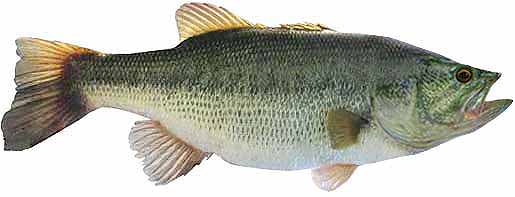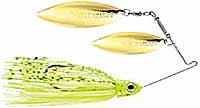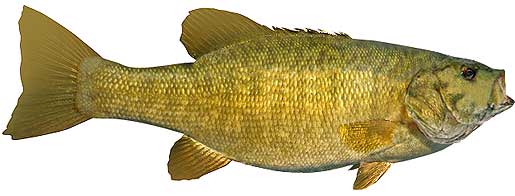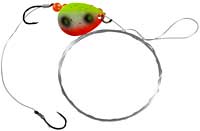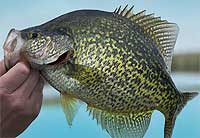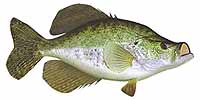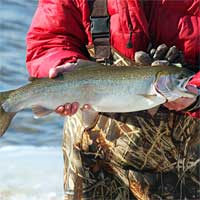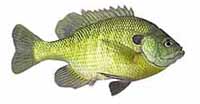Fishing Report For Brookville Lake, IN
By Rick Seaman
January 1, 2025
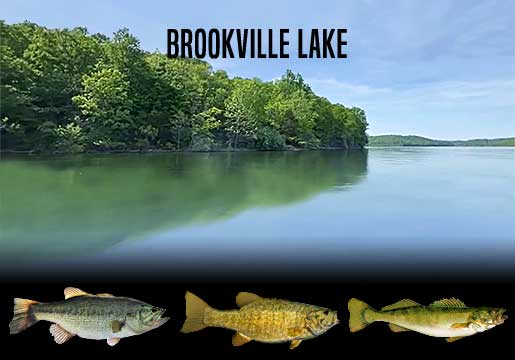
Fishing Reports
Popular Fish Species Brookville Lake, IN
Largemouth Bass
Current Report: Good
FALL. Now that Fall has arrived, bass here have moved shallow, following schools of baitfish into coves and shallow bays around 4 to 15 feet of water. Brookville Lake is considered one of the better bass fisheries in the area. While you can catch largemouth bass throughout the lake, the northern sector, from Fairfield to Dunlapsville, is often the most productive. Currently topwater, jerkbaits, crankbaits, and slow-rolled spinnerbaits are catching most of the bass. Later in Fall, as deeper water cools, bait and bass move out to ledges, channel edges, points and humps where flutter spoons, jigs and drop shots are often good choices in 8 to 15 feet of water.
WINTER. Winter will isolate largemouth around slightly deeper structure, flats, points and creek channels. They can be found from 15 to 25 feet deep. Here they hold, feeding less frequently, awaiting warmer water to return in Spring. Slow presentations are key to getting bites.
SPRING. Once water temperatures rise into the low 60's, largemouth will move from deep wintering holes, to shallower water nearby spawning areas. Vibrating jigs, jerkbaits and spinnerbaits typically get bites just away from the shoreline. At this time they are feeding aggressively in about 5 to 10 feet of water, and preparing for the spawn. Once water warms into the mid to high 60's, they will move into 2 to 4 feet of water, and create nests, then lay their eggs. Immediately afterwards, females move to deeper water and males remain to guard the eggs, and then the fry. After a couple weeks, the males also move to slightly deeper water. Deep-diving crankbaits, vibrating jigs, plastic worms and swimbaits are catching bass during this period.
SUMMER. Water temperatures will warm considerably in Summer. Bass will feed shallow, early and late in the day, where they will be caught on topwater, crankbaits and swimbaits. Wacky-rigged stick worms always catch finicky bass when the bite is slow. Largemouth bass here feed on gizzard shad, small sunfish and crawfish. During the hotter parts of the day, they are being caught on points, channel edges, and ledges 10 to 25 feet deep.
Smallmouth Bass
Current Report: Good To Very Good
Brookville Lake is also an excellent smallmouth bass fishery.
FALL. As Fall arrives, smallmouth here follow schools of baitfish into coves and bays 5 to 10 feet deep. Locals report the preponderance of smallmouth bass being caught from the dam to the Fairfield Causeway Bridge. Crankbaits which imitate crawdads, appeal to smallmouth here. Jerkbaits and slow-rolled spinnerbaits, are also successful. Fishing shallow for smallmouth is often good on cold, windy, cloudy and rainy days.
WINTER. Winter will isolate them around deeper structure, points, flats and creek channels, often suspending in open water above these features. They can generally be found from 15 to 25 feet deep. Tube baits, jigging spoons, drop shots and Ned rigs often produce when fished with a very slow presentation. Here they hold, feeding less frequently, awaiting warmer water to return in Spring.
SPRING. When water temperatures rise into the 50's now, smallmouth have moved from deep wintering spots to shallower water, just outside spawning areas. They feeding heavily in 5 to 10 feet of water at this time, and are typically caught on jerkbaits, crankbaits, tube baits, Ned rigs, and crayfish imitating plastics. Once water warms into the high 50's, they move into shallower water, and create nests in gravel or sand areas, then lay their eggs. Females then move to deeper water and males remain to guard the eggs, and then the fry. After a couple weeks, the males also move to 10 to 15 feet deep, and feed aggressively. Crankbaits, tube baits, Ned rigs, plastic worms, spoons and swimbaits are catching smallies during this period.
SUMMER. Smallmouth bass, including a few trophy-size gems, are currently feeding shallow early and late in the day, where they are being caught on topwater, crankbaits, swimbaits, Ned rigs and tube baits. Smallmouth bass here feed on crawfish, gizzard shad, and small sunfish. They prefer rocky or gravel bottom areas, as this is where crayfish live. During the hotter parts of the day, they are being caught on points, humps, and ledges 10 to 25 feet deep. Often these deeper fish are part of a large school of smallmouth.
Walleye
Current Report: Fair To Good
In Spring and Fall, Other times, t
FALL. Fall brings cooler temperatures to shallow water, drawing walleye and baitfish shallower. Wolf Creek and Templeton Creek, are good areas to find shallow walleye. Jigs, swimbaits, spoons, crankbaits, jerkbaits, and spinnerbaits are all historically good for catching walleye this time of year. Early Fall finds them in 10 to 20 feet of water. Later in Fall, they move out deeper again. Dragging jigs or worm harnesses with nightcrawlers or leeches, or bottom bouncers, around ledge drop-offs catches walleye fairly consistently. Watch for the bigger walleye to be slightly deeper than the majority of the school.
WINTER. This Winter fishing for walleye was decent. The deeper end of the lake from the Brookville Lake Dam to the Fairfield area is the primary walleye water. Anglers report catching them in 20 to 30 feet of water, along creek channel edges, rocky humps and ledges. Slow trolling the main lake body with bait rigs or deep-diving crankbaits work well. They primarily feed on small fish, staying close to the bottom. Blade baits, jigs, swimbaits, spoons, deep-diving crankbaits, and worm harness spinners, are all working while deep trolling or slow drifting.
SPRING. Early Spring brings warming water in the shallows, and draws walleye here to feed, especially rocky areas and inlet channels. In Spring, Wolf Creek and Templeton Creek are good areas to find shallow walleye. Here, in 5 to 15 feet deep, they will spawn once the water warms to the mid to high 40's. When they move shallow, bright colored jigs, tipped with minnows or nightcrawlers typically catch them. Spinnerbaits, jerkbaits and crankbaits are also working when walleye are up shallow. Afterwards, they move to 15 to 30 feet deep around points, flats, shoals and ledges, nearby shore, often staying in close proximity to their spawning locations.
SUMMER. Water temperatures rise in Summer, and walleye fishing is good if you can get your bait deep enough. Walleye tend to concentrate in 10 to 30 feet of water, preferring the cooler temperatures. The deeper end of the lake from the Brookville Lake Dam to the Fairfield area is the primary walleye water. Throughout Summer, early in the morning, and from dusk to long after dark are good times to catch walleye. At those times they move slightly shallower to feed in low-light conditions. Night fishing is often good in Summer, as well. The rest of the time they are cruising flats and creek channel edges, where they are harder to locate. When the bite is slow, grubs and nightcrawlers, fished just off the bottom are catching walleye.
Fishing Video
Fish species to fish for...
Guide to fishing for largemouth bass, smallmouth bass, channel catfish, flathead catfish, black crappie, white crappie, walleye, rainbow trout, brown trout, bluegill and muskellunge at Brookville Lake in Indiana.
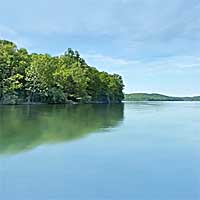 This 5,200 acre lake is located immediately north of Brookville, in the southeastern part of the state. At over 17 miles in length, there is ample water for fishing and a nice variety of fish species to pursue. Enjoy!
This 5,200 acre lake is located immediately north of Brookville, in the southeastern part of the state. At over 17 miles in length, there is ample water for fishing and a nice variety of fish species to pursue. Enjoy!
Primary fish species to catch
Click images for fishing tips and details about each species.
Today's Weather & Forecast
Marinas
Click here for marinas.
Public Boat Launch Ramps & Landings
Click here for boat ramps.
Click here for a Indiana Fishing License.
Map - Fishing & Access
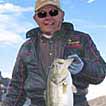 Rick Seaman is a fishing enthusiast with over five decades of fishing experience, a retired tournament fisherman, author of numerous published articles on fishing, and co-author of the book "Bass Fishing - It's not WHAT you throw, It's WHERE you throw it".
Rick Seaman is a fishing enthusiast with over five decades of fishing experience, a retired tournament fisherman, author of numerous published articles on fishing, and co-author of the book "Bass Fishing - It's not WHAT you throw, It's WHERE you throw it".
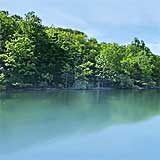 Contact Information
Contact Information
Brookville Lake Office
14108 IN-101
Brookville, IN 47012
765 647-2657
Fishing lakes in each state
100725
Brookville Lake Report
INDIANA


Walleye, muskie and trout fishing in east-central IN.


